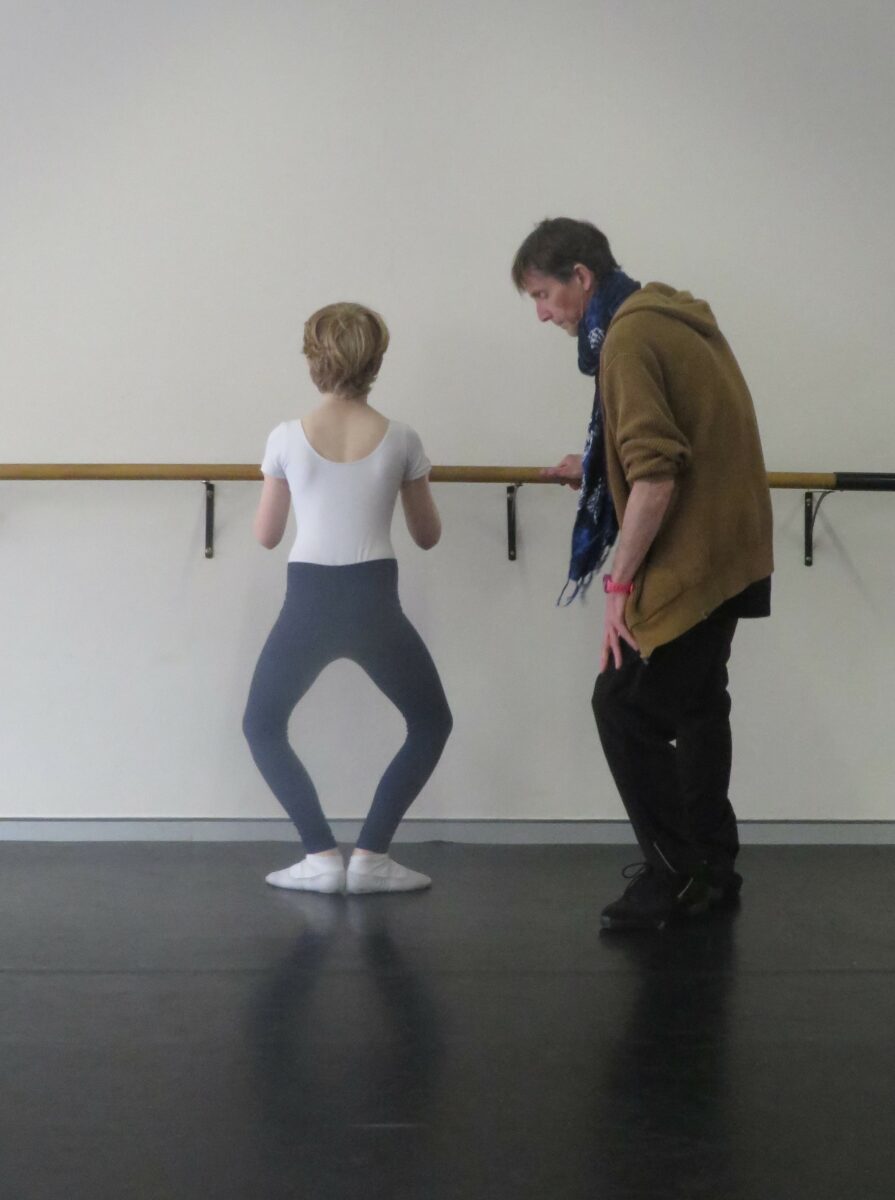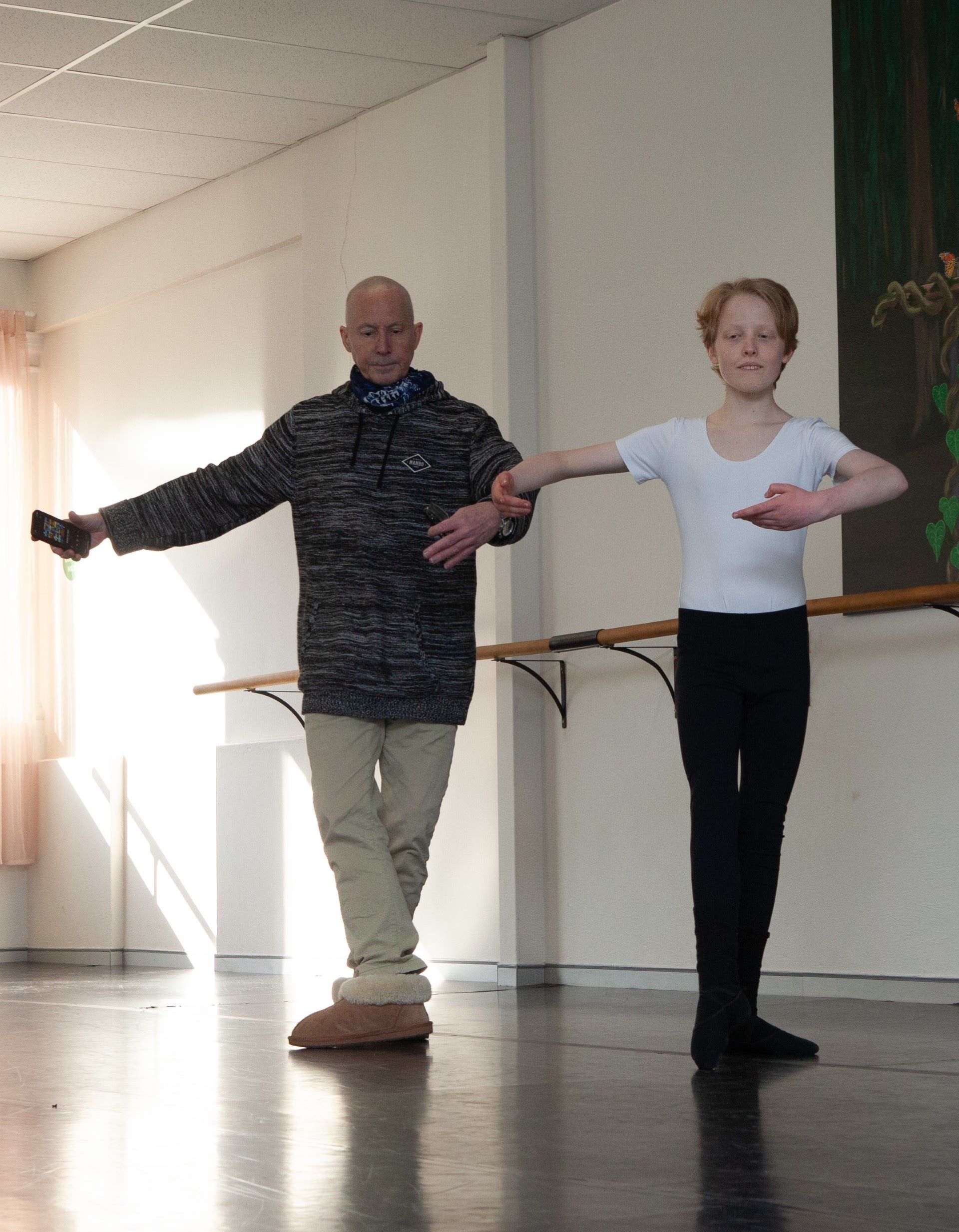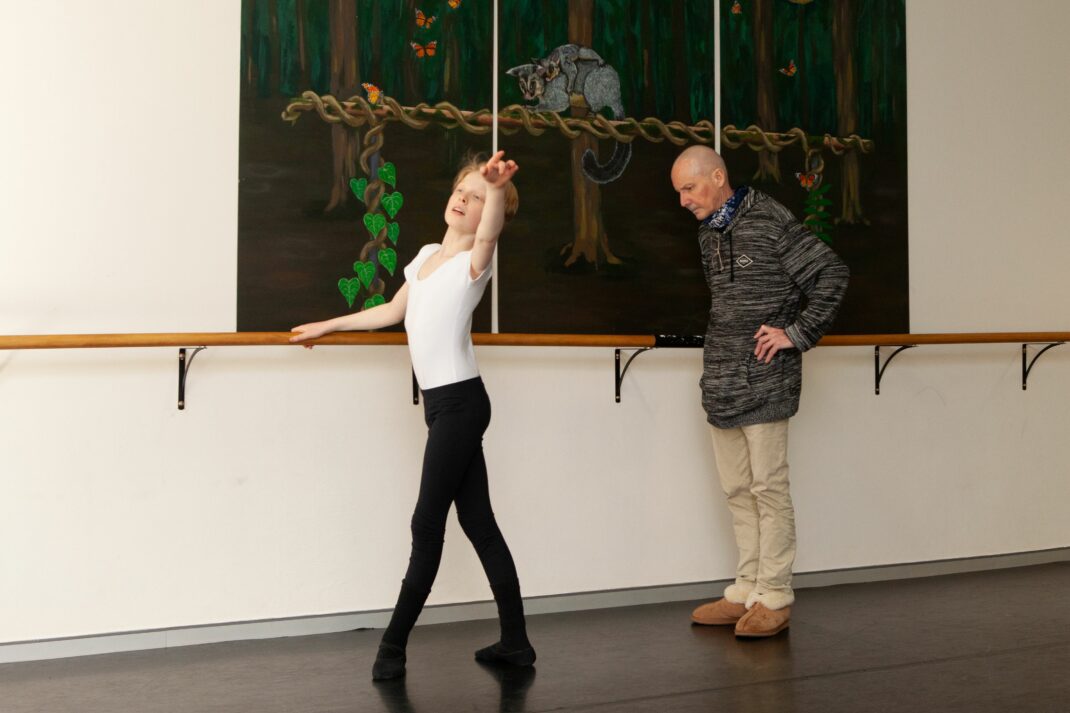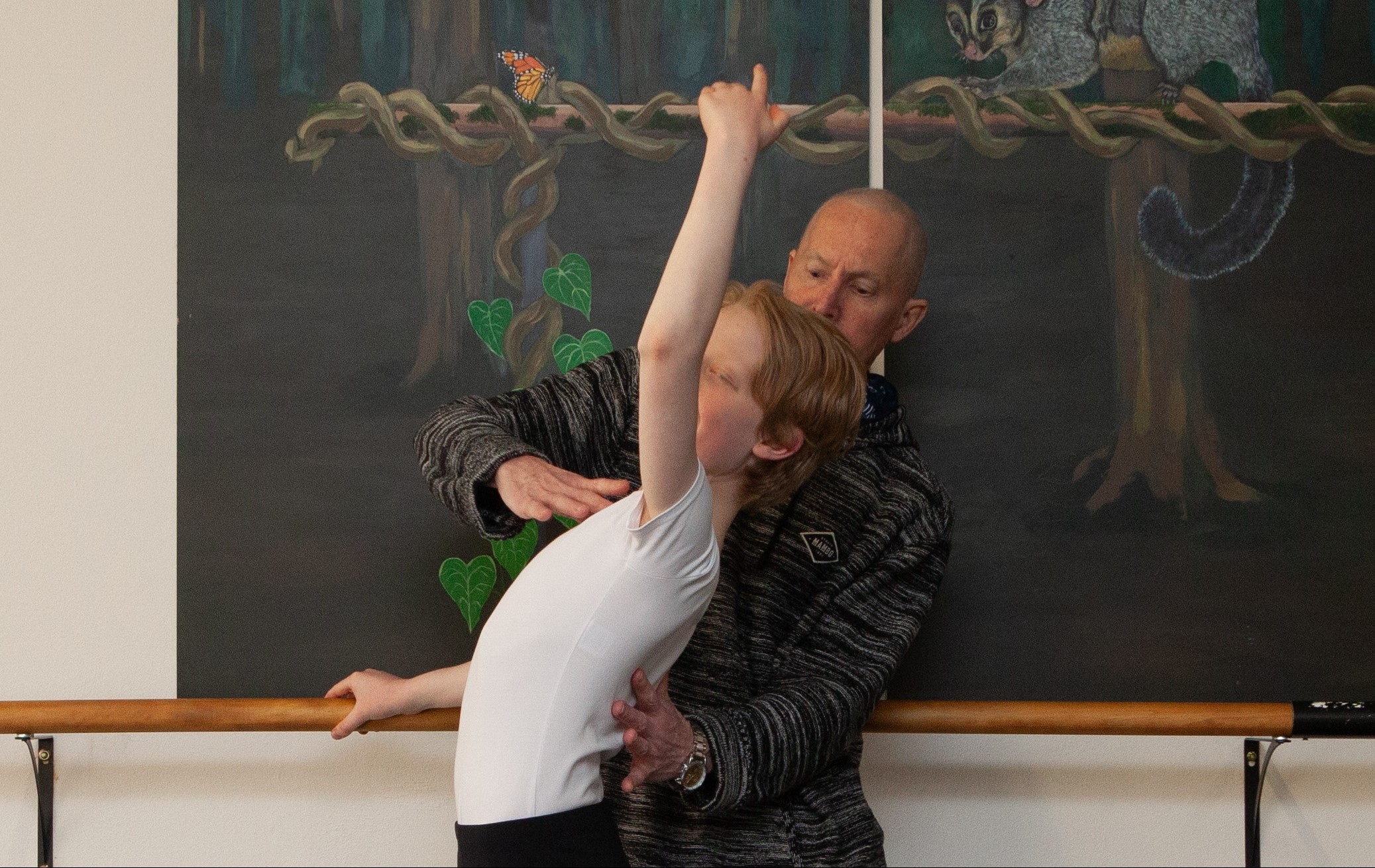For over two decades Martin James had a stellar career as a principal dancer with a range of ballet companies, including Royal New Zealand Ballet, English National Ballet, Deutsche Oper Berlin, and Royal Danish Ballet. When he retired from performing in 2005, with a knighthood from Queen Margrethe II of Denmark for his contribution to Danish ballet, he took up teaching in Copenhagen and was appointed ballet master at Royal Danish Ballet. Teaching then became his main occupation and has continued to be so to the present day. Over the past 18 months or so I have, on occasions, had the pleasure of watching him teach in Canberra, a city he visits on weekends from his current home in Sydney. He now has a number of private pupils in Canberra.
Just recently I sat down with him to ask about his approach to teaching ballet. I was especially interested in the effect that the technique of August Bournonville might have had on his approach, given that Bournonville was a strong part of the early days of Royal New Zealand Ballet and, of course, is embedded in Royal Danish Ballet practices. His response included:
In the Royal Danish Ballet itself we did Bournonville classes. We didn’t do them every day but we did the curriculum. And of course Royal New Zealand Ballet was founded by Poul Gnatt who was a Dane. So I have been given quite a lot of knowledge of the Bournonville technique during my time with those two companies. Today, in most classes I’ll put in a bit of Bournonville, but it won’t be a Bournonville class. It will be integrated into a normal, classical situation. It’s often a challenge for students because Bournonville is hard. We forget that it’s actually a technique on its own. It’s fast and it’s often good to put it into a class because it reminds us of how slow we actually are.
Then we went on to talk about what exactly constitutes good teaching, a subject that is of intense interest to him.
I’m quite passionate about teaching. I think there’s a lot of confusion with the work of some teachers. As a dancer there was nothing worse for me than having teachers, and especially guest teachers, come into a studio with a full company present, pretending that they were the best teachers in the world and making it completely obvious that they were being complex and complicated. All the people who might have been doing shows in the evening thought, ‘Really! Just give us a basic class.’ That happened quite lot and it still happens today. You have to consider what teaching is about. We have to consider who we are working for—is it for ourselves, or for people we are hoping to make better dancers? My performing career is over. I had a good career and I retired on a good note. But I was still doing well and people would say to me sometimes, ‘Don’t you miss it?’ No! For me teaching is the next progression and I’m really, really basic when I teach so we can think about what technique is all about rather than be complicated in our minds. That can cause injuries. That’s my belief.


Martin had more to say about injuries and their management.
If we are moving towards becoming a professional, we have to understand what that means physically. As a professional you might be working seven days a week if you are travelling or touring. You never stop. So what I say to young people before they even get to that situation is that when you are very tired you can easily get injured because your mind goes in a different direction. Everything becomes uncoordinated. You can’t do that in a company. You need to concentrate on your technique even if that means moving slowly. You can’t mess it up. You need to understand what your body is doing.
*******************
The above is a very brief selection of what we talked about but it gives an idea of Martin’s approach and his passion for teaching. We might have to wait for a book to learn more about his extraordinary career!

Michelle Potter, 14 August 2023
Featured image (detail): Martin James teaching in Canberra, 2023. Photo: © Tim Potter

What a little gem of an interview. It is heartening to read about a teacher who values clarity and can distill so much of his performance experience into the young dancer in front of him in the studio…
… and lovely too, in this 70th year of RNZBallet, to be reminded of the Bournonville heritage that was transplanted here by Poul Gnatt so long ago.
Some years ago in wonderful wonderful Copenhagen, I was thrilled to watch Martin teaching at Royal Danish Ballet when he was Ballet Master there, and everything he says in this interview reflects the clarity and calm I remember of those classes. You watch Martin take up 5th position, arms bras bas, a hint of épaulement this way and a diagonal eyeline the other, he hasn’t even moved yet but you just know that everything is going to be alright. And it is.
How wonderful your contribution is and fascinating your history as a dancer. No wonder the profound ability I could see all those years ago and exceptional ballon. I am so looking forward to your book
How blessed today’s dancers are to learn from a master who allows them to think and train thoroughly to develop into fine dancers with a profound understanding. Bravo Martin James
I well remember Martin James as a dancer with London Festival Ballet/ENB when I first started watching ballet. I always enjoyed his performances including some memorable ones as Onegin. It’s lovely reading about what he is up to now. Thanks
Thanks Martin xxx
Martin is a wonderful teacher and mentor. Not just for those at the start of their careers but all the way through to retirement. He sees the whole picture and gives space for a dancer to find their best way of being. I definitely think a book about his career would be a great read. It would involve large chunks of documented dance history that many would appreciate 😄
Thanks to those who have commented so far on this post. Interest in Martin’s book is clear! Work on editing and expanding on what has been written so far will begin soon.
I’d like to place a pre-publication order please…
We’ll start a list!
Thanks, Michelle, for this fine piece of writing. Although I have not seen Martin James dancing or teaching, it is clear from this article that he is a teacher-artist – he understands how to establish ballet’s principles, melding the technique and style so artistry can blossom as the body and mind are ready. The boy in these photos looks at home in his body, and that is a hallmark of good teaching.
I danced with Poul Gnatt and also did his Bournonville classes in preparation for dancing ‘Le Conservatoire’. Poul’s breeding was clear – everything just fell where it should – no. fuss, just natural manliness, ease and aplomb. For the rest of us, his Bournonville classes were a foreign dance language, and very difficult.
It’s so heartening to hear about the enduring memories people have of Poul Gnatt — and his pedigree stagings of Bournonville works here and elsewhere. He told us a marvellous story about performing La Sylphide back at Royal Danish Ballet for his Gala “retirement” (he’d already been gone for more than ten years!). I’ll tell it to Martin so he can include it in his book — it’s too good to summarise here.
x Jennifer
Hi everyone. I’d like to say a thank-you for these statements made over the days since my interview with Michelle Potter!
Teaching is important in both dance and in education generally and my passion these days is in helping students to understand the basics of classical ballet and also to understand their futures!
I’m no advocate but we must be careful of the rubbish we are sometimes sent. We must call on everyone to help our artists and the Arts in general! New Zealand and Australia have very believable integrity and talent but success depends on directions!
Thanks to you all.
lieber Martin !
Der Artikel mit den Ausschnitten aus dem Interview über Dein Unterrichtsstil übers tanzen,
und die darauf folgenden Antworten, der verschiedenen Tänzern, Tänzerrinnen und anderen
bedeutenden Persönlichkeiten, denen Du begegnest bist haben mir gut gefallen.
Du bringst ein Buch heraus, dafür wünsche ich Dir viel Glück und eine Gute Hand um alles
so darzustellen, wie Du es für richtig und wichtig hälst.
Alles liebe zu Deinem Geburtstag , Glück, Gesundheit, Erfolg und Alles Gute für Dein Ballett-
unterricht und Dein Buch.
lovely regard Beate und Ingo aus Berlin
Dear Beate, my German is good enough to read and understand your lovely message to Martin, but not good enough to reply ‘auf Deutsch’. Martin tells me he knows you from Deutsche Oper Berlin and when he reads your comment I’m sure he will be thrilled to hear from you. Thank you for the comment. Michelle
My daughter learned the RAD syllabus in NZ for 11 years. Eventually she had a South African teacher who had qualified to teach Cecchetti (not valued in NZ, it seems), and her demonstrations of some of the exercises opened my eyes to other possibilities than ‘just’ RAD. My daughter also went to some of Martin’s intensives. The part I loved most when watching his classes was the port de bras at the end of the barre. In RAD, an exercise named ‘Port de Bras’ always seemed to involve the legs and feet moving too. But Martin would stand there in fifth, with just his arms, head, and upper body moving. It was beautiful, and in my Silver Swans classes now I sometimes ask the teacher if we can have an exercise ‘just’ for port de bras. Some of them understand, but others look puzzled. I’m no expert, but I think dancers need to know how to communicate without using their legs and feet, and Martin’s exercises demonstrated this perfectly. He has been so generous in passing on his deep knowledge and love of dance.